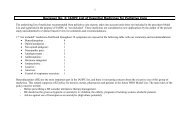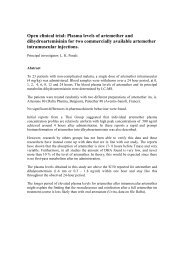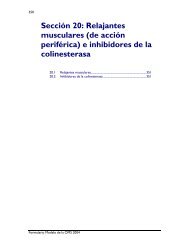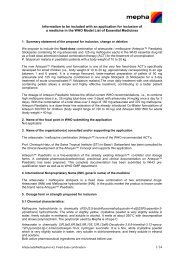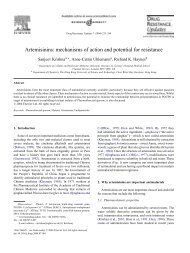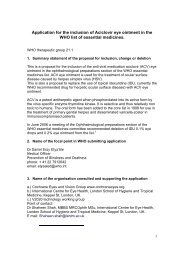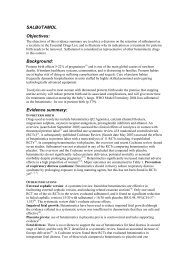SODIUM VALPROATE IN CHILDHOOD EPILEPSY
SODIUM VALPROATE IN CHILDHOOD EPILEPSY
SODIUM VALPROATE IN CHILDHOOD EPILEPSY
You also want an ePaper? Increase the reach of your titles
YUMPU automatically turns print PDFs into web optimized ePapers that Google loves.
seizures (generalised tonic-clonic seizures, absence and myoclonus) while phenytoin<br />
is more effective than valproate monotherapy in partial onset seizures (simple partial,<br />
complex partial and secondary generalised tonic-clonic seizures).<br />
The object of this review was to assess the best evidence comparing phenytoin and<br />
valproate when used as monotherapy in people with partial onset seizures or<br />
generalised onset tonic-clonic seizures with or without other generalised seizure<br />
types. The review includes randomised controlled trials in children or adults treated<br />
with phenytoin or valproate as monotherapy.<br />
Data were available for 669 individuals from 5 trials, representing 60% of the<br />
participants recruited into the 11 trials that met the inclusion criteria. One important<br />
limitation is that in 4 of the 5 trials, for people classified as having generalised onset<br />
seizures, tonic-clonic seizures were the only seizure types recorded at follow-up and<br />
hence results apply only to generalised tonic-clonic seizures.<br />
The outcome measures included were<br />
- time to withdrawal of allocated treatment (primary outcome) – if treatment<br />
was withdrawn for poor seizure control, adverse effects, non-compliance or if<br />
additional add-on treatment was initiated<br />
- time to achieve 12 month remission (seizure free period)<br />
- time to achieve 6 month remission<br />
- time to first seizure post randomisation<br />
- quality of life measures if available<br />
The following results were:<br />
(a) time to withdrawal of allocated treatment<br />
For people with generalised seizures, there was no clear advantage for either<br />
drug. For people with partial onset seizures, there was a potentially important<br />
advantage for valproate. Overall, there is a suggested potential overall advantage<br />
for valproate.<br />
(b) time to achieve 12 month remission<br />
For people with generalised (tonic-clonic) or partial onset seizures, there was no<br />
clear advantage for either drug.<br />
(c) time to achieve 6 month remission<br />
the most compatible analysis including only generalised tonic-clonic seizures<br />
suggested a potentially important advantage for valproate. For people with partial<br />
onset seizures, there was no clear advantage for either drug. Overall, a potential<br />
overall advantage for valproate is suggested.<br />
(d) time to first seizure post randomisation<br />
the most compatible analysis including only generalised tonic-clonic seizures<br />
indicated no clear advantage for either drug. For those with partial onset<br />
seizures, there was a potentially important advantage for phenytoin. Overall,<br />
results suggest a potential overall advantage for phenytoin<br />
(e) quality of life<br />
This was not recorded in any trial<br />
As such, the review failed to demonstrate a statistically significant effect in favour<br />
of either valproate or phenytoin for the primary global outcome ‘time to withdrawal<br />
of treatment’. This outcome is influenced by the relative efficacy of the 2 drugs as<br />
well as differences in tolerability and safety. There was also a failure to<br />
demonstrate any statistically significant differences between phenytoin and<br />
Sodium valproate page 6



